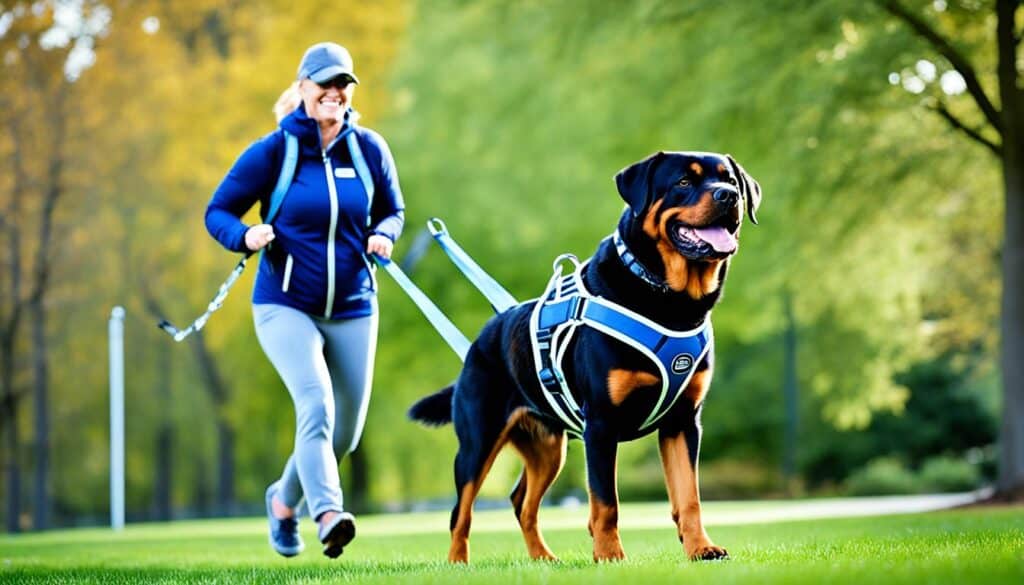Hip dysplasia is a common health issue in Rottweilers. It affects their lifespan and quality of life. This problem happens when the hip joint doesn’t form right.
This leads to the hip moving oddly, which wears down the cartilage. Over time, this causes osteoarthritis. Even though it’s often from birth, things like keeping a healthy weight and when you spay or neuter can play a role.
To help Rottweilers with hip dysplasia, early detection and the right care are key. Sometimes, surgery may be needed. Knowing about this condition can make a big difference for Rottweiler owners. It means they can take steps to ensure their dogs have a happy and active life.
Key Takeaways:
- Hip dysplasia is a common health issue in Rottweilers that can significantly impact their lifespan.
- Recognizing the signs of hip dysplasia and seeking early intervention is crucial for managing the condition.
- Proactive management strategies such as weight control, exercise, physical therapy, and medication can improve a Rottweiler’s quality of life.
- In severe cases, surgical options may be recommended to alleviate pain and improve mobility.
- Rottweilers may face other common health problems, and taking preventative measures is essential for their overall well-being.
Understanding Hip Dysplasia in Rottweilers
Hip dysplasia affects the hip joint of dogs, like Rottweilers. It happens when the joint doesn’t develop right, causing misalignment. This issue is mostly due to genes but can also be worsened by things like quick weight gain and early spay/neuter.
Defining Canine Hip Dysplasia
Hip dysplasia is a common problem in dogs. It happens when the hip joint’s ball and socket don’t fit well. As a result, there’s joint instability, surface grinding, and over time, arthritis.
Causes and Contributing Factors
Genetics are the major cause of hip dysplasia in Rottweilers. It can be passed down and certain Rottweiler lines are more at risk. But, how fast they gain weight as they grow and early spay/neuter are also influencers. They stress the joints, upping the hip dysplasia chance. If spay/neuter happens too soon, before growth plates close, it messes with normal bone development.
Identifying Signs of Hip Dysplasia
Spotting hip dysplasia signs early in your Rottweiler is key. Signs to look out for include:
- Bunny-hopping gait
- Limping or lameness, particularly in the hind legs
- Difficulty getting up or climbing stairs
- Stiffness, especially after rest
- Decreased muscle mass in the hind legs
If these signs show in your Rottweiler, see a vet. They can diagnose and work out a treatment plan.
How Long Do Rottweilers Live with Hip Dysplasia
Rottweilers with hip dysplasia may live different lengths of time, depending on several things. These include how bad the hip dysplasia is, what care they get, and their overall health. But, with quick spotting of the issue and careful care, many can live long. They might live as long as Rottweilers without hip dysplasia. Giving them the right care and love is key to their long life.

It’s very important to manage a Rottweiler’s weight if they have hip dysplasia. Keeping them at a healthy weight lowers stress on the hips and slows arthritis risk. A diet made just for them can help a lot. It keeps them healthy and happy longer.
Moving and therapy are also very important for these dogs. These can make their lives better. Doing exercises helps their hip muscles, boosts movement, and eases pain. Always work on these with a vet or someone who knows about dog rehab.
Some medicines and supplements can also help with hip dysplasia. For pain and swelling, your vet might suggest nonsteroidal anti-inflammatory drugs. Glucosamine and chondroitin are great for joint health. They can lower joint wear and tear.
Seeing the vet regularly is crucial. They check your Rottweiler’s health and manage their care plan. This means they can keep up a good treatment, adjusting it to fit your dog’s needs. This helps your pet live their best life, despite the condition.
Taking good care of a Rottweiler with hip dysplasia focuses on managing their weight, giving them ways to move better, and using the right medicines. All this helps them live well and maybe even longer. The goal is to give them a full and happy life, tailored to their health needs.
Diagnosing Hip Dysplasia in Rottweilers
Diagnosing hip dysplasia in Rottweilers involves looking at both genes and the environment they live in. Genes from a Rottweiler’s parents are a big part of this. But, things like how much they weigh and when they are spayed or neutered also matter.
Some dogs are more likely to get hip dysplasia because of their genetic makeup. Good breeders should avoid mating dogs with a history of hip dysplasia. Responsible breeding choices can cut down on this problem.
Beyond genes, what a dog goes through can also play a role. Being overweight or obese can make hip dysplasia worse. The time a dog is spayed or neutered is key too because it affects bone growth.
When a Rottweiler might have hip dysplasia, a vet’s checkup is crucial. The vet will look at how the dog walks and moves its hips. They check for any signs that the dog is in pain. Feeling the hip joint helps them spot issues.
For a clear view, a vet might use X-rays or CT scans. These tools can show the hip joint’s condition in detail. They help the vet figure out how bad the hip dysplasia is.
Proactive Management of Hip Dysplasia
Managing hip dysplasia in Rottweilers is key to enhancing their life quality. It’s also vital to slow down the disease. Proactive management includes looking after their weight, diet, and encouraging exercise. Medications and supplements are also part of the approach.
Weight Control and Diet
Keeping the right weight is critical for Rottweilers with hip dysplasia. Extra weight strains their hip joints more, making the condition worse. This can lead to arthritis. A healthy weight reduces their pain and makes them more comfortable.
Regular exercise and a nutritious diet are essential. They prevent weight gain and keep the joints healthy. These steps are crucial in managing hip dysplasia.
Exercise and Physical Therapy
Exercise and therapy are key in managing hip dysplasia. Tailored exercises help strengthen hip muscles and stabilize the joint. This boosts the Rottweiler’s mobility. Activities like swimming and walking are good because they’re gentle on the joints.
Physical therapy, such as hydrotherapy, maintains flexibility and eases pain. It’s a big help in treatment.

Medications and Supplements
Medications and supplements are also important. A vet may recommend NSAIDs to lower pain and inflammation. Supplements, like glucosamine and chondroitin, can aid joint health. These can enhance movement and relieve symptoms. Always talk to a vet about what your Rottweiler needs.
Surgical Treatments and Prognosis
If hip dysplasia is severe, surgery might be the best solution to reduce pain and move better. For Rottweilers, surgeries like hip replacements, femoral head osteotomy, and other operations are available.
Each surgery has pros and cons. The best one for a Rottweiler depends on its age, health, and how bad the hip dysplasia is.
After the surgery, how things go can differ. Yet, with the right rehab and post-op care, Rottweilers often see a big jump in their life quality.
Rottweiler Breed Health Issues Beyond Hip Dysplasia
Hip dysplasia is a key health concern for Rottweilers. But there are other serious health issues too. Knowing about these helps Rottweiler owners keep their pets healthy and happy for longer.
Common Health Problems in Rottweilers
Rottweilers face many health challenges, like:
- Aortic stenosis
- Elbow dysplasia
- Entropion
- Ectropion
- Cruciate ligament ruptures
- Osteochondritis dissecans (OCD)
- Cancer (osteosarcoma and lymphoma)
- Juvenile laryngeal paralysis & polyneuropathy (JLPP)
- Allergies
These problems can differ in how serious they are. They need varying ways to treat them. Working closely with a vet to spot and deal with these issues early is key for your Rottweiler’s health.
Preventative Health Measures
Preventing health problems in Rottweilers is key. Here are some steps to help:
- Ensure regular veterinary check-ups to monitor the dog’s health and address any issues promptly.
- Follow appropriate vaccination schedules to protect against common diseases.
- Provide a balanced and nutritious diet to support optimal health.
- Implement regular exercise routines to maintain a healthy weight and promote overall fitness.
By following these steps, Rottweiler owners can keep their pets safe and healthy. This cuts down on many common health problems.
Factors Affecting Rottweiler Lifespan
Various factors like genetic traits, how they are bred, and their environment influence a Rottweiler’s life span. These include how well families took care of their health and the places they lived. Their lifestyle and health habits matter a lot for how long they live, just like with people.
Genetic Predispositions and Breeding
The genes a Rottweiler inherits can affect its life span. Good breeding practices are key to fighting genetic health problems like hip dysplasia. By selecting healthy parents, breeders reduce the chance of their puppies getting sick.
Environmental Factors and Lifestyle
A Rottweiler’s life span is also shaped by its home and daily habits. Having a safe home, good food, and plenty of exercise boosts their longevity. Also, keeping them mentally and socially active, and with regular vet visits, keeps them healthy.
Knowing about these life-extending factors helps breeders and owners alike. They can make choices that help Rottweilers live long, healthy lives.
Conclusion
Hip dysplasia is a big issue for Rottweilers and can cut their life short. But, with the right care, they can live just fine. Weight control is a key part. Also, they need the right kind of exercise and sometimes help from meds or surgery.
Dealing with other health problems early is also crucial. This helps Rottweilers have a longer, healthier life. Owners play a big role in making sure their Rotties are well taken care of.
Tackling hip dysplasia head-on takes work, but the effort is worth it. Rottweilers can have a great life when care is given. Their families will enjoy many years of happiness with them.
